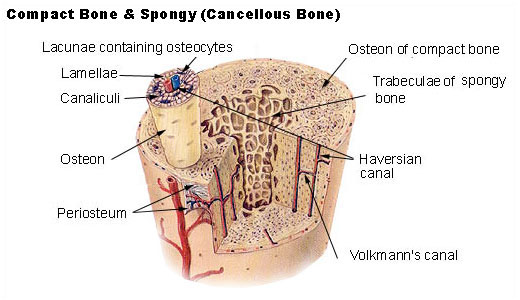Difference Between Haversian Canal and Volkmann's Canal
Table of Contents
The key difference between Haversian canal and Volkmann’s canal is that Haversian canal is the central canal of the osteon that carries blood vessels and nerves while Volkmann’s canal is the perforating canal that connects Haversian canals with each other and with the periosteum.
Osteon or Haversian system is the structural unit of a compact bone. It is a cylindrical shaped structure and mainly has two components. They are concentric lamellae and Haversian canal. Concentric lamellae surround the Haversian canal. Therefore, the Haversian canal is at the centre of each osteon. There is another type of canal called Volkmann’s canal in the compact bone. They are perforating canals. Moreover, they are small canals through which the bone transmits blood vessels from outside into the Haversian canals in order to communicate. Moreover, Volkmann’s canals interconnect Haversian canals.
CONTENTS
1. Overview and Key Difference
2. What is Haversian Canal
3. What is Volkmann’s Canal
4. Similarities Between Haversian Canal and Volkmann’s Canal
5. Side by Side Comparison – Haversian Canal vs Volkmann’s Canal in Tabular Form
6. Summary
What is Haversian Canal?
Haversian canal is the central canal of an osteon. It allows blood vessels, lymph vessels and nerves to travel through it. In one Haversian canal, one or two capillaries and nerve fibres can be seen. Generally, a compact bone has many Haversian canals running through each osteon. They are actually microscopic tubes.

Figure 01: Haversian Canal
The blood vessels in the Haversian canal nourish the osteocytes. Therefore, the capillaries in the Haversian canals bring oxygen and nutrients to the bone and remove wastes. Furthermore, the Haversian canal runs along the length of a Haversian system. Hence, in a cross-section of a bone, it appears as a hole within concentric lamellae.
What is Volkmann’s Canal?
Volkmann’s canals, also known as perforating channels, are transverse branches of Haversian canals. Thus, these canals show transverse orientation within the bone. They are tiny canals that interconnect Haversian canals with each other. Furthermore, these canals connect Haversian canals with the periosteum and transmit blood vessels from the periosteum to the bone.

Figure 02: Volkmann’s Canal
Moreover, Volkmann’s canals connect adjacent osteons of the compact bone. Similar to Haversian canals, Volkmann’s canals also provide energy and nourishment to the osteons.
What are the Similarities Between Haversian Canal and Volkmann’s Canal?
- Haversian canal and Volkmann’s canal are two types of canals found in compact bones.
- Both allow blood vessels and nerve fibres to travel through them.
- Volkmann’s canals interconnect Haversian canals with each other and with the outer covering of the bone.
- Both types of canals provide nourishment to the osteons.
What is the Difference Between Haversian Canal and Volkmann’s Canal?
Haversian canal is the central canal of an osteon that allows blood vessels, lymph vessels and nerves to travel along the osteon. In contrast, Volkmann’s canal is a transverse branch of a Haversian canal that interconnects Haversian canals with each other and with the periosteum. Thus, this is the key difference between Haversian canal and Volkmann’s canal. Furthermore, Haversian canal shows longitudinal orientation while Volkmann’s canal shows transverse orientation.
The below infographic summarizes the difference between Haversian canal and Volkmann’s canal.
Summary – Haversian Canal vs Volkmann’s Canal
Haversian canal is the central canal of an osteon. It contains blood vessels, lymph vessels and nerves. The blood vessels of the Haversian canal supply and nourish the osteocytes. In contrast, Volkmann’s canal is a transverse branch of a Haversian canal. These canals interconnect Haversian canals and also bring blood vessels from the periosteum to the Haversian canals. Haversian canal runs longitudinally in the Haversian system while Volkmann’s canals run in a transverse orientation. Both canals allow blood vessels and nerves to travel; hence, they provide energy and nutrients to the bone. This summarizes the difference between Haversian canal and Volkmann’s canal.
Reference:
1. “Haversian Canal.” Wikipedia, Wikimedia Foundation, 30 Apr. Available here.
2. “Volkmann’s Canals.” Volkmann’s Canals – an Overview | ScienceDirect Topics, Available here.
Image Courtesy:
1. “Transverse section of bone en” By Source digital bitmap graphics: BDBRecreated in vector format: Nyq – Original analog graphics: Gray’s Anatomy of the Human Body from the classic 1918 publication available online at Bartleby.com Own work (CC BY-SA 4.0) via Commons Wikimedia
2. “Illu compact spongy bone” By SEER – U.S. National Cancer Institute’s Surveillance, Epidemiology and End Results (SEER) Program (Public Domain) via Commons Wikimedia
ncG1vNJzZmivp6x7pbXFn5yrnZ6YsqOx07CcnqZemLyue8OinZ%2Bdopq7pLGMm5ytr5Wau260wK%2Bcq6uZlrtur8CnmKVlkaOxbsLOpaKmmZ6jwG6vwKeYpWc%3D